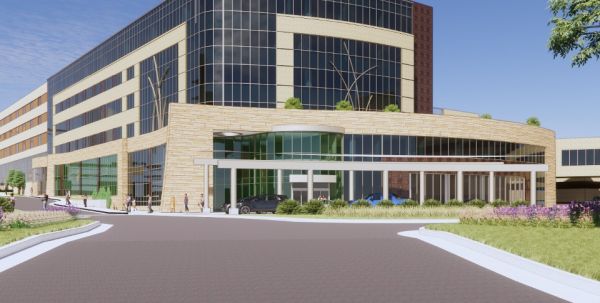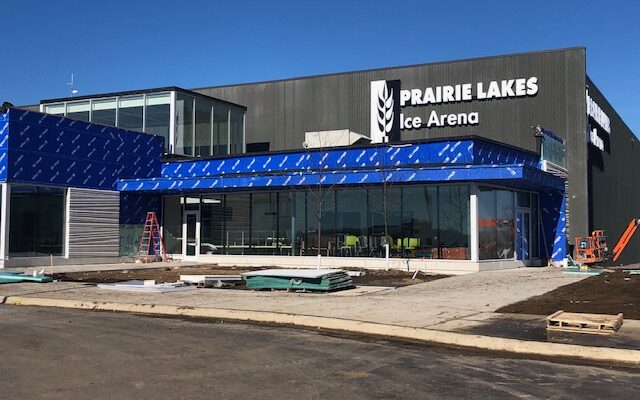Avera Health unveils $245 million expansion plan in Sioux Falls

March 28, 2024
McKenzie Huber (SD Searchlight)
SIOUX FALLS, S.D.–Avera Health plans to expand two of its Sioux Falls campuses at a cost about $245 million.
It’ll be the largest expansion of hospital patient care space in Sioux Falls history at 350,000 square feet, according to the health care system.
The planned six-story and three-story buildings are meant to expand capacity and access for two specialties in South Dakota: digestive health services and pregnancy and labor services.
Avera spokesman Cale Feller told South Dakota Searchlight that the health care system “often has very full facilities.” The system serves about 42,000 inpatients each year, with another 1.1 million served outside of its hospital settings. The Avera McKennan hospital in Sioux Falls serves patients within a 300-mile radius of the city.
The building projects will ease strain and demand on the Avera system, which includes 300 locations throughout South Dakota, Minnesota, Iowa, Nebraska and North Dakota, Avera President and CEO Jim Dover said in a press release.
The projects, he said, are “foundational to the quality of care we’re able to deliver as an interconnected system.”
“Years of planning and research have gone into evidence-based care for the population we serve, and I’m confident this project will benefit patients for generations to come,” he said.
South Dakota’s preterm birth rate has risen in the past decade, from 7.9% of live births in 2011 to 9.4% in 2020. According to the South Dakota Department of Health Pregnancy Risk Assessment Monitoring System 2021 report — the latest available — 10.1% of mothers surveyed had a preterm birth, which increases the risk of sudden infant death syndrome and long-term health issues.
Over 25% of infants had to stay at the hospital for more than two days, according to the survey. And the percentage of women reporting gestational diabetes during pregnancy was 14.9%.
The six-story building will add 158 beds for women’s and children’s hospital services at Avera’s McKennan Hospital campus in Sioux Falls, create a new front entrance for the hospital and expand some existing facilities, according to the news release. The tower will be dedicated to labor and delivery, postpartum care, newborn nursery, neonatal intensive care unit, pediatric hospital care and pediatric intensive care.
Many counties – especially in western South Dakota – are considered maternal health care deserts, meaning there isn’t a hospital or birth center offering obstetric care in the county. Native American South Dakotans are most likely to live in such areas. According to South Dakota Public Broadcasting (SDPB), Avera researchers are looking to understand barriers to Native American maternal health.
The Avera Research Institute was awarded federal grant funding of up to $58 million over seven years to conduct such research.
From 2012 to 2021, American Indians made up 20% of all live births, but 44% of all pregnancy-associated deaths.
“It’s crisis levels,” Amy Elliot, chief research officer at Avera McKennon, told SDPB. “With the lack of obstetrics providers especially on the western side of the state. How do we find solutions, not just for recruiting more people, but also do we have to think a little bit different about how we deliver care?”
Feller said the health care system has multiple initiatives to support rural health care, including telemedicine neonatal intensive care; obstetricians and gynecologists placed in regional centers such as Mitchell, Aberdeen and Pierre to reduce travel time for births; and remote monitoring and training for rural center sonographers to reduce travel for high-risk pregnancy patients.
Digestive health services, or gastroenterology, covers everything involving the digestive tract, including gallbladder disease and pancreatic and colon cancer.
Pancreatic cancer diagnoses are on the rise in South Dakota — increasing from 2.2 cases per 100,000 people in 2002 to 13.2 in 2020, according to the National Cancer Institute — along with liver cancer (3.5 to 7.2 for the same timeframe). Stomach and colon cancers diagnoses are trending downward.
But with the 2021 federal recommendation to start colon cancer screenings five years sooner to age 45, the specialty has become “busy,” Feller said.
“Colonoscopy is a crucial preventive measure against colorectal cancer, which is the third most common cancer diagnosed in both men and women in the United States and the second leading cause of cancer-related deaths in both women and men,” Feller added.
The three-story building project will expand digestive health services on the Louise Health Campus, where there is a growing need for capacity and access.
Gastroenterology services are currently located in the Avera Specialty Hospital and its attached medical building. The space vacated within the Avera Specialty Hospital by digestive health services will be used for orthopedic services.
The projects are expected to break ground this summer and be completed in 2026 for the Louise project and 2027 for the main hospital campus project.
The health care system also plans to renovate other Sioux Falls locations. The South Dakota Health and Educational Facilities Authority will consider a plan to finance up to $465 million in bonds to Avera Health for the projects and refinance projects at its meeting on Thursday.
Avera plans to move its hospital oncology unit to the fifth floor of the Prairie Center on the main campus. The move is a “domino effect” of the two major projects, Feller said.
Avera will also build out its clinic space at the southeastern Sioux Falls Dawley Farm location to accommodate specialty providers at the clinic, and it plans to create a new 18-bed unit for patients at Avera St. Luke’s Hospital in Aberdeen.




